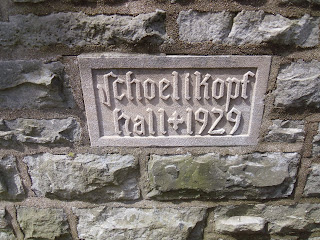






While home for Easter, I decided to check out this historical sight in Niagara Falls, New York. What brought my attention to this area was the local newspaper. The Niagara Gazette have had some articles running about a carriage house dated to the Civil War.
This property was deeded to Judge Samuel DeVeaux in the mid 1850's as the Deveau College for Orphans and Destitute Children. Samuel DeVeaux was a large contributor to the Lockport and Niagara Railroads, and was instrumental in the construction of the Whirlpool Bridge. His business dealings resulted in a vast land purchase along the Niagara River, that still beares his name. The judge died in 1852.
For nearly 80 years, the course work at this school included military like drills and students dressed in uniforms that resembled West Point. The last day of military influence on the campus was in 1950.
Buildings on the property at one time included Van Rensselaer Hall, Monro Hall, Schoellkopf Hall, Edgewood, the Walker Residence, the Buscaglia-Castellani Art Gallery, a carriage house, boiler house and three residential homes. The 51-acre site grew to encompass a campus of nearly a dozen buildings and residences.
DeVeaux College fell on hard times as the demand for prep-school education continued to decline in the 20th century and the Episcopal Diocese ceased operations at the school and, in 1971, looked to another organization to accept the burden of taking care of the historic structures. Subsequent property owners or lessees include Niagara County, Niagara Falls, Niagara University, Board of Cooperative Educational Services, Niagara County Community College and currently New York State Office of Parks Recreation and Historic Preservation who christened the property DeVeaux Woods State Park.
The property was listed on the National Register of Historic Places in 1974.
The Niagara Gazette has been publishing articles in relation to this area.
They are about an old Civil War Era Carriage House; the city would like to demolish this historic building. WHY? Its listed as a Historical Sight...
Please Read the following Link.
http://niagara-gazette.com/local/x7460654/State-delays-plans-to-demolish-Carriage-House



















 The battle of Cedar Creek was fought on October 19, 1864 between Lt. Gen Jubal Early of the Confederate, and Maj. gen. Phillip Sheridan of the Union during the height of The Valley Campaign of 1864. 32,000 Union soldiers and 11,000 Confederate soldiers. 8,000 casualties total. The battle was a Union victory.
The battle of Cedar Creek was fought on October 19, 1864 between Lt. Gen Jubal Early of the Confederate, and Maj. gen. Phillip Sheridan of the Union during the height of The Valley Campaign of 1864. 32,000 Union soldiers and 11,000 Confederate soldiers. 8,000 casualties total. The battle was a Union victory.



























